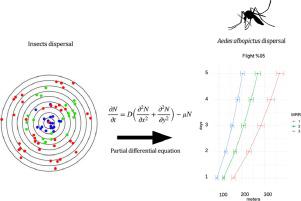Ecological Modelling ( IF 2.6 ) Pub Date : 2021-07-06 , DOI: 10.1016/j.ecolmodel.2021.109658 Chiara Virgillito 1, 2 , Mattia Manica 1, 3, 4 , Giovanni Marini 1, 4 , Beniamino Caputo 2 , Alessandra della Torre 2 , Roberto Rosà 1, 5

|
Dispersal is an important driver for animal population dynamics. Insect dispersal is conventionally assessed by Mark-Release-Recapture (MRR) experiments, whose results are usually analyzed by regression or Bayesian approaches which do not incorporate relevant parameters affecting this behavior, such as time dependence and mortality. Here we present an advanced mathematical-statistical method based on partial differential equations (PDEs) to predict dispersal based on MRR data, taking into consideration time, space, and daily mortality. As a case study, the model is applied to estimate the dispersal of the mosquito vector Aedes albopictus using data from three field MRR experiments. We used a two-dimensional PDE heat equation, a normal bivariate distribution, where we incorporated the survival and capture processes. We developed a stochastic model by specifying a likelihood function, with Poisson distribution, to calibrate the model free parameters, including the diffusion coefficient. We then computed quantities of interested as function of space and time, such as the area travelled in unit time. Results show that the PDE approach allowed to compute time dependent measurement of dispersal. In the case study, the model well reproduces the observed recapture process as 86%, 78% and 84% of the experimental observations lie within the 95% CI of the model predictions in the three releases, respectively. The estimated mean values diffusion coefficient are 1,800 (95% CI: 1,704–1 896), 960 (95% CI: 912- 1 128), 552 (95% CI 432–1 080) m2/day for MRR1, MRR2 and MRR3, respectively. The incorporation of time, space, and daily mortality in a single equation provides a more realistic representation of the dispersal process than conventional Bayesian methods and can be easily adapted to estimate the dispersal of insect species of public health and economic relevance. A more realistic prediction of vector species movement will improve the modelling of diseases spread and the effectiveness of control strategies against vectors and pests.
中文翻译:

使用偏微分方程模拟节肢动物的活动扩散:以白纹伊蚊为例
分散是动物种群动态的重要驱动因素。昆虫传播通常通过标记-释放-重新捕获 (MRR) 实验进行评估,其结果通常通过回归或贝叶斯方法进行分析,这些方法不包含影响这种行为的相关参数,例如时间依赖性和死亡率。在这里,我们提出了一种基于偏微分方程 (PDE) 的先进数学统计方法,以根据 MRR 数据预测扩散,同时考虑时间、空间和每日死亡率。作为案例研究,该模型用于估计蚊媒白纹伊蚊的传播使用来自三个现场 MRR 实验的数据。我们使用了二维 PDE 热方程,一个正态二元分布,我们在其中合并了生存和捕获过程。我们通过指定具有泊松分布的似然函数开发了一个随机模型,以校准模型自由参数,包括扩散系数。然后我们计算了作为空间和时间函数的感兴趣的数量,例如单位时间内行驶的区域。结果表明,PDE 方法允许计算散布的时间相关测量。在案例研究中,模型很好地再现了观察到的重新捕获过程,因为在三个版本中,86%、78% 和 84% 的实验观察值分别位于模型预测的 95% CI 之内。估计平均值扩散系数为 1,800 (95% CI: 1,704–1 896),MRR1、MRR2 和 MRR3 分别为2 个/天。与传统的贝叶斯方法相比,将时间、空间和每日死亡率结合在一个方程中可以更真实地表示传播过程,并且可以很容易地调整以估计与公共卫生和经济相关的昆虫物种的传播。对病媒物种移动的更现实的预测将改进疾病传播的建模以及针对病媒和害虫的控制策略的有效性。











































 京公网安备 11010802027423号
京公网安备 11010802027423号